Micromechanics Modeling of Transverse Tensile Strength for Unidirectional CFRP Composite
Abstract
1. Introduction
2. Materials and Methodology
2.1. Determination of Homogenized Stress in the Fiber and Matrix
2.2. Stress Concentration Factor of Matrix under Transverse Loads
2.3. Failure Criteria for Constituents of a Composite under Transverse Tension
2.4. Specimen Preparation
2.5. Testing Methods
3. Results and Discussion
3.1. Predicted Results
3.2. Transverse Tensile Strength Test
3.3. Scanning Electron Microscope (SEM)
4. Conclusions
- Instead of traditional definition by mechanics of fracture, using line-averaged stress divided by volume-averaged homogenized stress in the present study, an explicit expression for the stress concentration factor of the matrix in a UD composite subjected to a transverse tension was derived. With the addition of that factor, the stress state in matrix was revised as input data for failure criterion of composite.
- Following the results of conducted experiments on six 90° CFRP specimens in this study, the predicted transverse tensile strengths of the specimens agree well with measured results for an averaged error of 5.5%, while the error is over 200% for the conventional method which ignores the effect of stress concentration on a matrix. Thus, the proposed micromechanics method is feasible in predicting strength of a UD composite.
- The measured transverse tensile strengths of the specimens spread between 40–61 MPa, all much smaller than the pure matrix tensile strength (87 MP), in contrast with common knowledge that the transverse tensile strength of a UD composite should be at least as large as the matrix tensile strength. The reason for the strength reduction is the stress concentration in the matrix by incorporation of fiber into composite.
- The failure surface of specimen was perpendicular to the loading direction, indicating that the failure mechanism of the matrix under transverse tension follows the maximum normal stress theory.
- SEM images showed different scaled microcracks in the matrix oriented to fiber direction, while the fibers are almost undamaged. The cracks were initiated in micron scale, about 10–30 μm, and then propagated to a large scale by increasing loads until the overall fracture of the composite. The SEM analysis demonstrates that failure of UD composites subjected to a transverse tensile load is mostly dependent on a failure of the matrix.
- It is recommended to further investigate the effect of stress concentration on a matrix for UD composite under other loading conditions, such as transverse compression, longitude loads, and combined loads. Furthermore, plasticity of matrix could be considered in future studies in an effort to achieve more effective design of an advanced composite.
Author Contributions
Funding
Institutional Review Board Statement
Informed Consent Statement
Data Availability Statement
Conflicts of Interest
Abbreviations
| Notation | |
| a, b | radius of fiber and matrix, respectively, in CCA model |
| [Aij] | a bridging tensor |
| , , , | longitudinal and transverse Young’s modulus, Poisson’s ratios, and shear moduli of a transversely isotropic fiber material |
| , , | Young’s modulus, Poisson’s ratio, and shear modulus of a matrix material |
| Vf, Vm | volume fraction of fiber and matrix, respectively |
| x1, x2, x3 | rectangular coordinates for a lamina to represent longitudinal, transverse, and through-thickness directions, respectively |
| z, ρ, φ | cylindrical coordinates for a geometry with a fiber inclusion embedded in a matrix to represent longitudinal, radial, and tangential directions, respectively |
| α, β | bridging parameters |
| position vector for a point in matrix for a given φ | |
| stress concentration factor of matrix in tensile direction | |
| σ11, σ22, σ12 | external stress components in composite in a rectangular coordinate system |
| ,,,,, | planar homogenized stress components in fiber and matrix respectively in rectangular coordinate system obtained by Bridging Model |
| ,,,,, | planar stress components in a (z, ρ, φ) coordinate system obtained by Bridging Model. |
| , , , | pointwise stress components in matrix obtained by CCA model |
| , | actual stress component of matrix and fiber in x2 direction |
| , | tensile strength of a pure fiber and a pure matrix obtained from experiments |
| ultimate tensile strength of a UD composite in transverse direction | |
References
- Farhangi, V.; Karakouzian, M. Effect of fiber reinforced polymer tubes filled with recycled materials and concrete on structural capacity of pile foundations. Appl. Sci. 2020, 10, 1554. [Google Scholar] [CrossRef]
- Minamisawa, T. Investigation of CFRP in aerospace field and improvement of the molding accuracy by using autoclave. AIP Conf. Proc. 2017, 1865, 080004. [Google Scholar] [CrossRef]
- Hinton, M.J.; Soden, P.D. Predicting failure in composite laminates: The background to the exercise. Compos. Sci. Technol. 1998, 58, 1001–1010. [Google Scholar] [CrossRef]
- Kondratiev, A.V.; Gaidachuk, V.E.; Kharchenko, M.E. Relationships between the ultimate strengths of polymer composites in static bending, compression, and tension. Mech. Compos. Mater. 2019, 55, 259–266. [Google Scholar] [CrossRef]
- Thushanthan, K.; Aponsu, G.M.D.N.; Gamage, J.C.P.H. Experimental Study on Tensile Strength Degradation of Carbon Fiber Reinforced Polymer (CFRP) Composite in Alkaline Environment. In Proceedings of the 2022 Moratuwa Engineering Research Conference (MERCon), Moratuwa, Sri Lanka, 27–29 July 2022; pp. 1–6. [Google Scholar] [CrossRef]
- Rao, P.M.V.; Rao, V.V.S. Degradation model based on Tsai-Hill factors to model the progressive failure of fiber metal laminates. J. Compos. Mater. 2011, 45, 1783–1792. [Google Scholar] [CrossRef]
- Li, S.; Sitnikova, E.; Liang, Y.; Kaddour, A.S. The Tsai-Wu failure criterion rationalised in the context of UD composites. Compos. Part A Appl. Sci. Manuf. 2017, 102, 207–217. [Google Scholar] [CrossRef]
- Kaddour, A.S.; Hinton, M.J. Maturity of 3D failure criteria for fibre-reinforced composites: Comparison between theories and experiments: Part B of WWFE-II. J. Compos. Mater. 2013, 47, 925–966. [Google Scholar] [CrossRef]
- Sun, Q.; Meng, Z.; Zhou, G.; Lin, S.P.; Kang, H.; Keten, S.; Guo, H.; Su, X. Multi-scale computational analysis of unidirectional carbon fiber reinforced polymer composites under various loading conditions. Compos. Struct. 2018, 196, 30–43. [Google Scholar] [CrossRef]
- Kar, N.K.; Hu, Y.; Barjasteh, E.; Nutt, S.R. Tension–tension fatigue of hybrid composite rods. Compos. Part B Eng. 2012, 43, 2115–2124. [Google Scholar] [CrossRef]
- Kim, D.W.; Lim, J.H.; Lee, S. Prediction and validation of the transverse mechanical behavior of unidirectional composites considering interfacial debonding through convolutional neural networks. Compos. Part B Eng. 2021, 225, 109314. [Google Scholar] [CrossRef]
- Soden, P.D.; Hinton, M.J.; Kaddour, A.S. Lamina Properties, Lay-Up Configurations and Loading Conditions for a Range of Fibre Reinforced Composite Laminates. In Failure Criteria in Fibre-Reinforced-Polymer Composites; Elsevier: Amsterdam, The Netherlands, 2004; pp. 30–51. [Google Scholar] [CrossRef]
- Kaddour, A.S.; Hinton, M.J. Input data for test cases used in benchmarking triaxial failure theories of composites. J. Compos. Mater. 2012, 46, 2295–2312. [Google Scholar] [CrossRef]
- Kaddour, A.S.; Hinton, M.J.; Smith, P.A.; Li, S. Mechanical properties and details of composite laminates for the test cases used in the third world-wide failure exercise. J. Compos. Mater. 2013, 47, 2427–2442. [Google Scholar] [CrossRef]
- Huang, Z.M.; Liu, L. Assessment of composite failure and ultimate strength without experiment on composite. Acta Mech. Sin. 2014, 30, 569–588. [Google Scholar] [CrossRef]
- Liu, L.; Huang, Z.M. Stress concentration factor in matrix of a composite reinforced with transversely isotropic fibers. J. Compos. Mater. 2014, 48, 81–98. [Google Scholar] [CrossRef]
- Nassiraei, H.; Rezadoost, P. SCFs in tubular X-joints retrofitted with FRP under out-of-plane bending moment. Mar. Struct. 2021, 79, 103010. [Google Scholar] [CrossRef]
- Huang, Z.M.; Xin, L.M. Stress concentration factor in matrix of a composite subjected to transverse compression. Int. J. Appl. Mech. 2016, 8, 1650034. [Google Scholar] [CrossRef]
- Pinho, S.T.; Iannucci, L.; Robinson, P. Physically based failure models and criteria for laminated fibre-reinforced composites with emphasis on fibre kinking. Part II: FE implementation. Compos. Part A Appl. Sci. Manuf. 2006, 37, 766–777. [Google Scholar] [CrossRef]
- González, C.; LLorca, J. Mechanical behavior of unidirectional fiber-reinforced polymers under transverse compression: Microscopic mechanisms and modeling. Compos. Sci. Technol. 2007, 67, 2795–2806. [Google Scholar] [CrossRef]
- Huang, Z.M.; Zhou, Y.X. Strength of Fibrous Composites; Zhejiang University Press: Hangzhou, China; Springer-Verlag: Berlin/Heidelberg, Germany, 2011; p. 65. [Google Scholar]
- Pindera, M.J.; Khatam, H.; Drago, A.S.; Bansal, Y. Micromechanics of spatially uniform heterogeneous media: A critical review and emerging approaches. Compos. Part B Eng. 2009, 40, 349–378. [Google Scholar] [CrossRef]
- Huang, Z.M.; Liu, L. Predicting strength of fibrous laminates under triaxial loads only upon independently measured constituent properties. Int. J. Mech. Sci. 2014, 79, 105–129. [Google Scholar] [CrossRef]
- Huang, Z.M.; Xin, L.M. In situ strengths of matrix in a composite. Acta Mech. Sin. 2017, 33, 120–131. [Google Scholar] [CrossRef]
- Chen, T.; Dvorak, G.J.; Benveniste, Y. Stress fields in composites reinforced by coated cylindrically orthotropic fibers. Mech. Mater. 1990, 9, 17–32. [Google Scholar] [CrossRef]
- Wang, Y.C.; Huang, Z.M. A new approach to a bridging tensor. Polym. Compos. 2015, 36, 1417–1431. [Google Scholar] [CrossRef]
- Karakouzian, M.; Farhangi, V.; Farani, M.R.; Joshaghani, A.; Zadehmohamad, M.; Ahmadzadeh, M. Mechanical characteristics of cement paste in the presence of carbon nanotubes and silica oxide nanoparticles: An experimental study. Materials 2021, 14, 1347. [Google Scholar] [CrossRef] [PubMed]
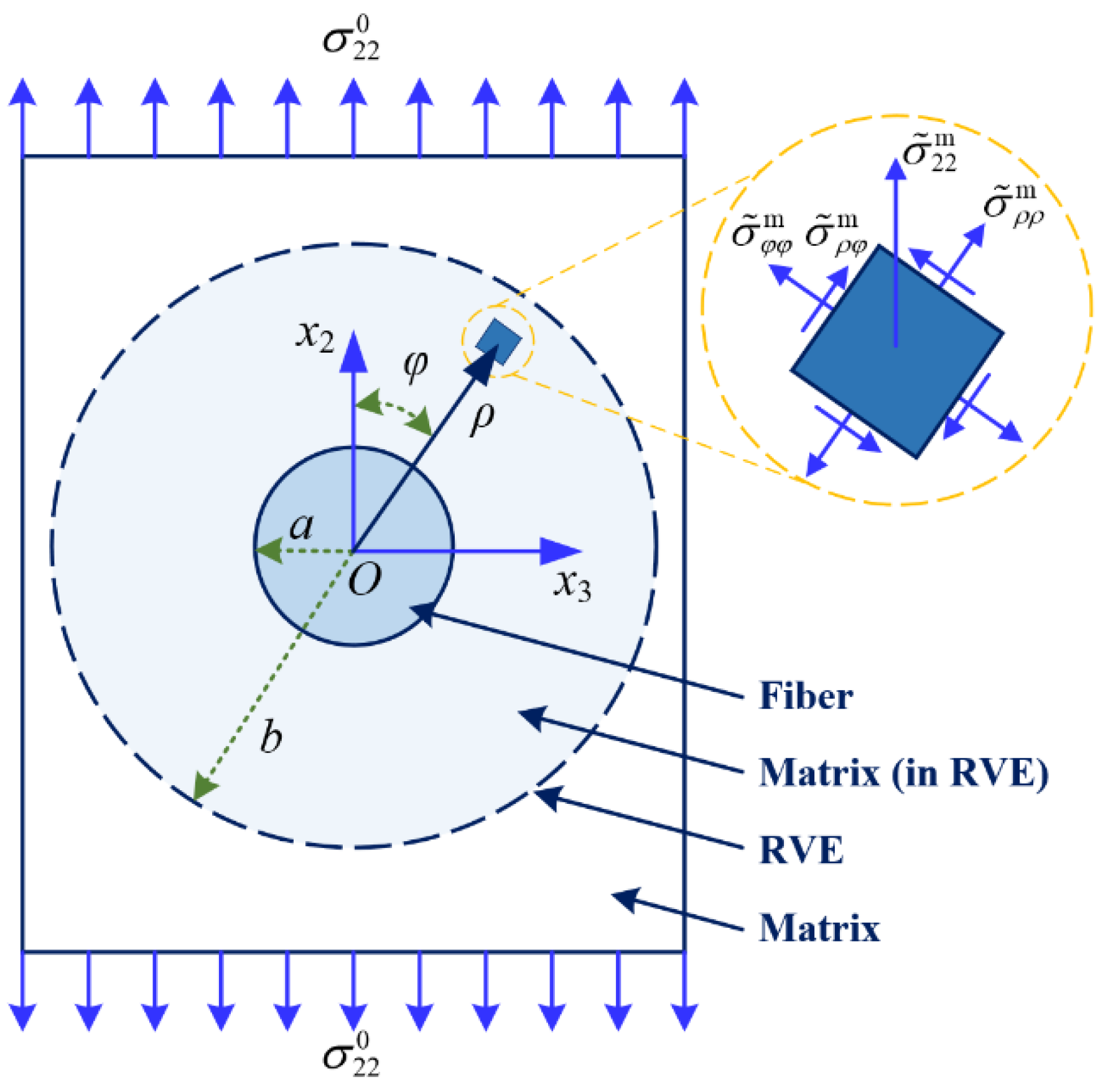
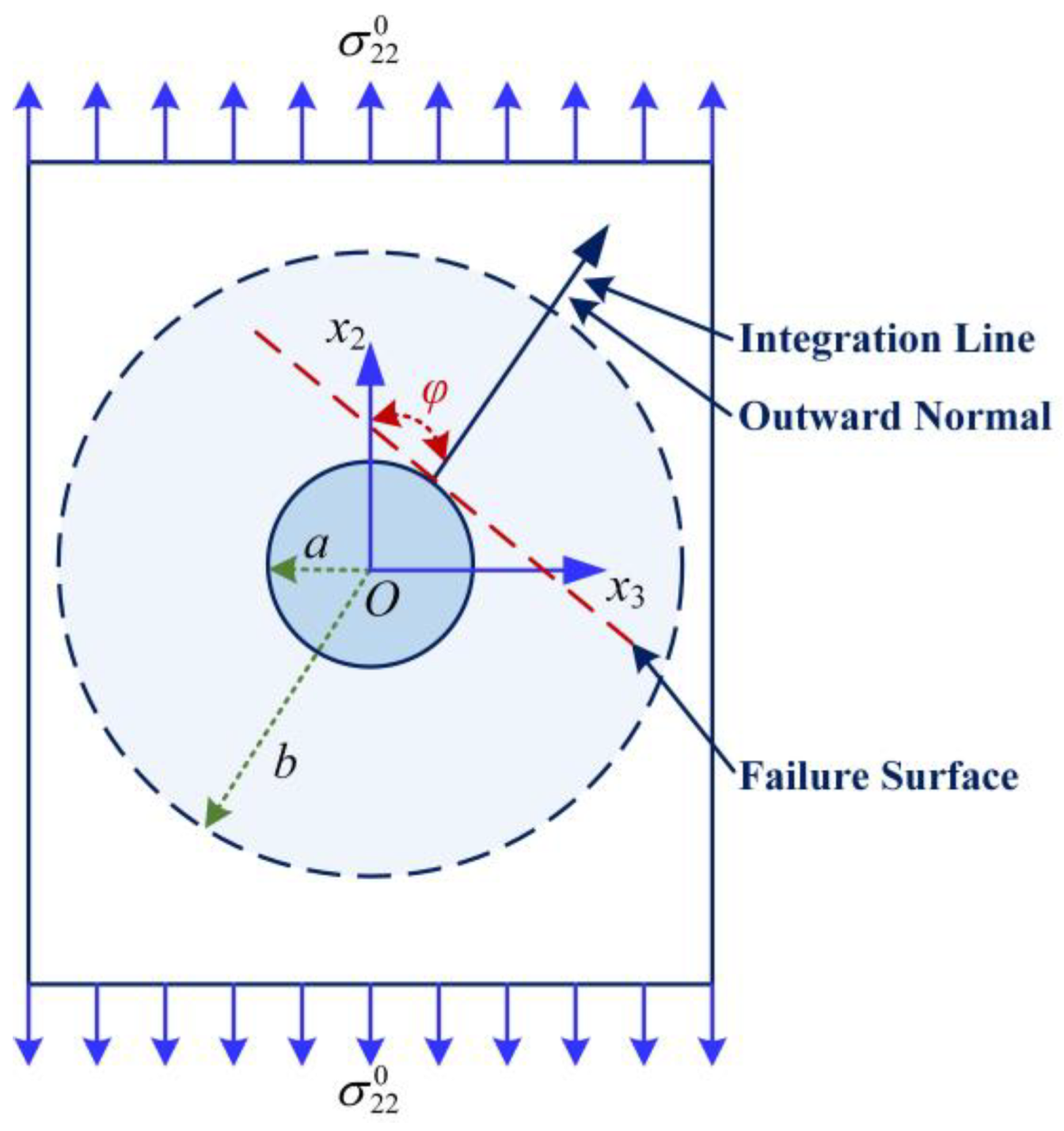

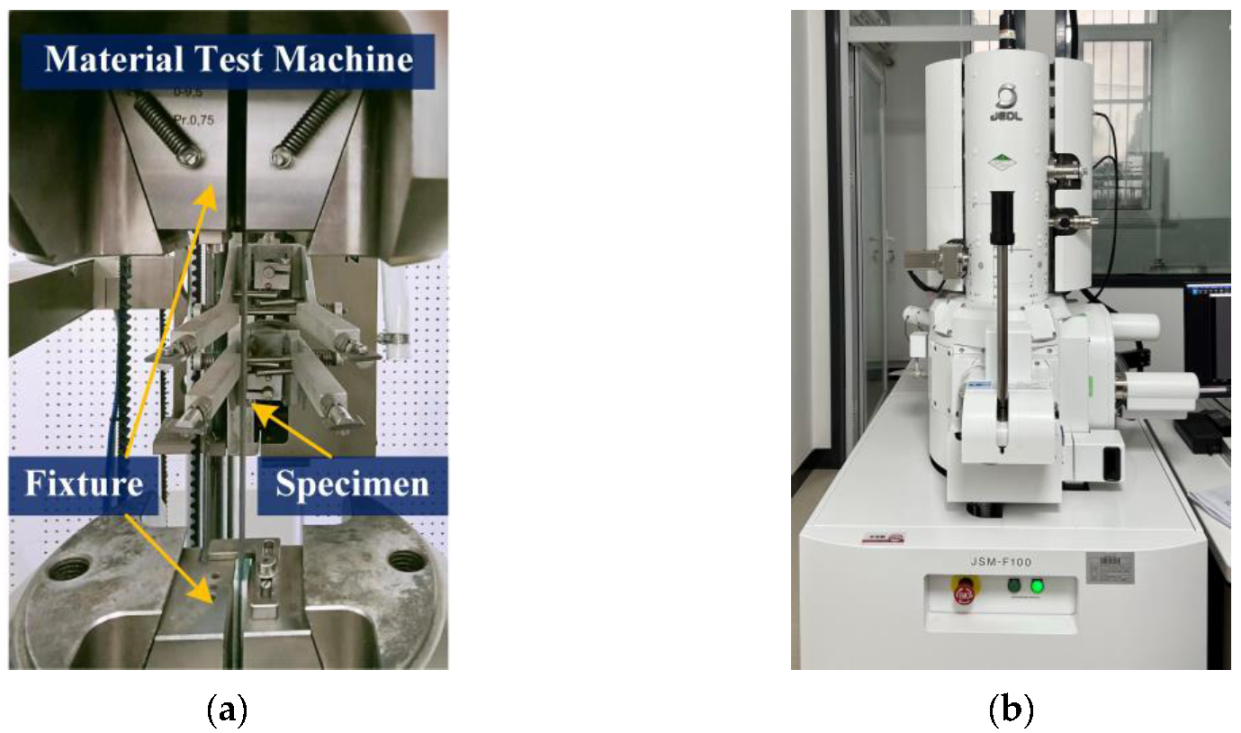


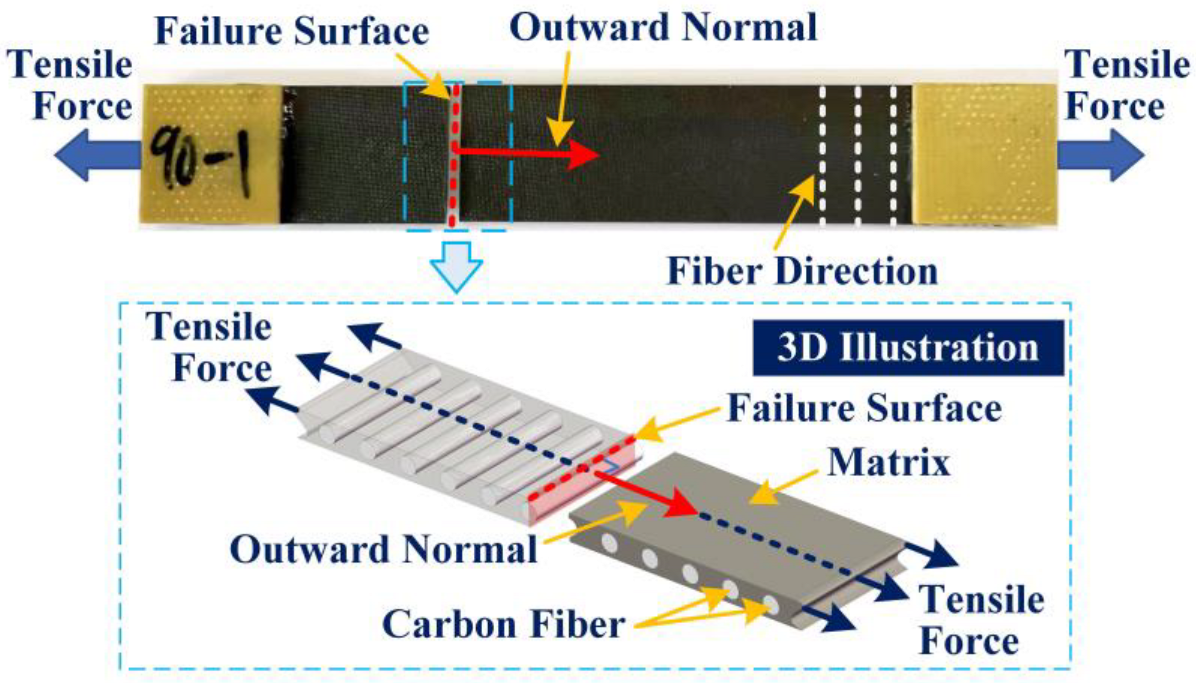
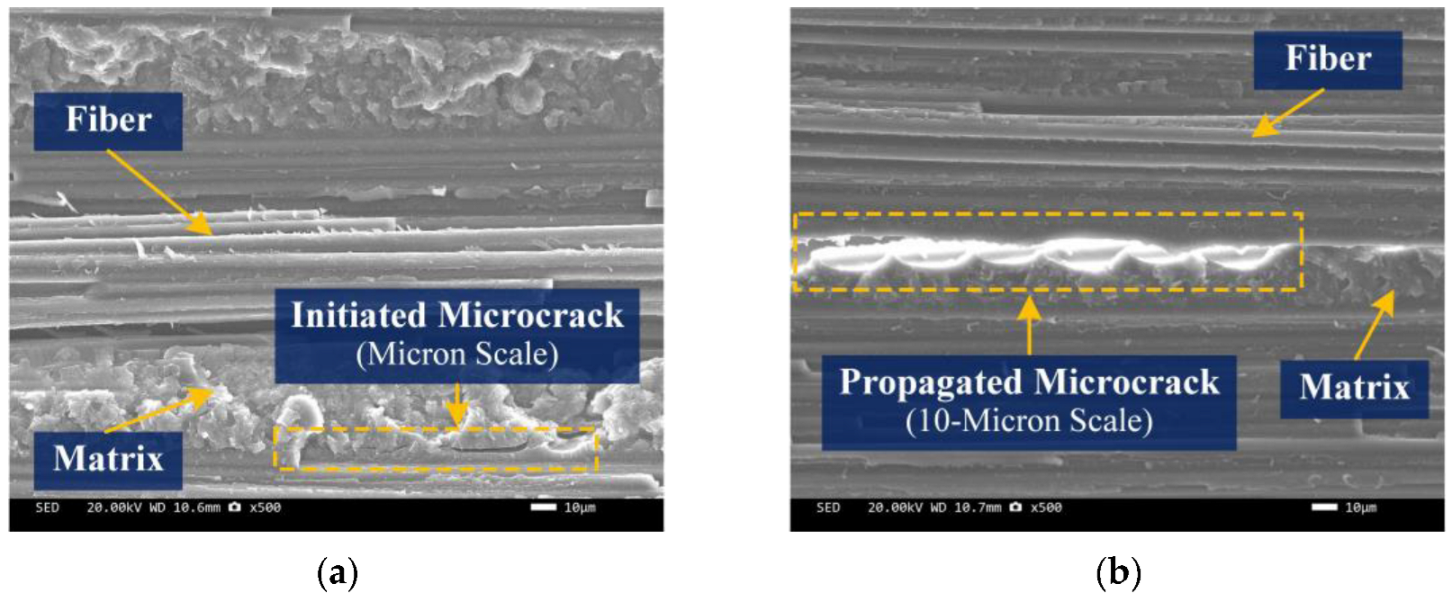
| Fiber CCF800H | Property | Matrix AC531 | Property |
|---|---|---|---|
| (GPa) | 294 | (GPa) | 3.6 |
| 0.45 | 0.35 | ||
| (MPa) | 5725 | (MPa) | 87 |
| Vf | 0.65 | Vm | 0.35 |
| Parameter | Value | Parameter | Value |
|---|---|---|---|
| l | 175 mm | δ | 1.5 mm |
| W | 25 mm | θ | 90° |
| h | 2 mm | Vf | 0.65 |
| D | 25 mm | - | - |
| Specimen No. | 1 | 2 | 3 | 4 | 5 | 6 | AVG * |
|---|---|---|---|---|---|---|---|
| Pure Matrix Tensile Strength/MPa | 87 | ||||||
| Predicted UD Transverse Tensile Strength/MPa (Bridging Model + ) | 58 | ||||||
| Predicted UD Transverse Tensile Strength/MPa (Bridging Model) | 169 | ||||||
| Measured UD Tensile Strength/MPa | 55 | 61 | 59 | 60 | 57 | 40 | 55 |
| Relative Error/% (Bridging Model + ) | 5.45 | −5.45 | −1.69 | −3.33 | 1.69 | 45 | 5.45 |
| Relative error/% (Bridging Model) | 207.27 | 177.05 | 186.44 | 181.67 | 196.49 | 322.50 | 207.27 |
Publisher’s Note: MDPI stays neutral with regard to jurisdictional claims in published maps and institutional affiliations. |
© 2022 by the authors. Licensee MDPI, Basel, Switzerland. This article is an open access article distributed under the terms and conditions of the Creative Commons Attribution (CC BY) license (https://creativecommons.org/licenses/by/4.0/).
Share and Cite
Liu, L.; Zhang, X.; Wang, Z.; Wang, Y.; Guo, J. Micromechanics Modeling of Transverse Tensile Strength for Unidirectional CFRP Composite. Materials 2022, 15, 8577. https://doi.org/10.3390/ma15238577
Liu L, Zhang X, Wang Z, Wang Y, Guo J. Micromechanics Modeling of Transverse Tensile Strength for Unidirectional CFRP Composite. Materials. 2022; 15(23):8577. https://doi.org/10.3390/ma15238577
Chicago/Turabian StyleLiu, Liangbao, Xiaohui Zhang, Zibiao Wang, Yana Wang, and Jiangzhen Guo. 2022. "Micromechanics Modeling of Transverse Tensile Strength for Unidirectional CFRP Composite" Materials 15, no. 23: 8577. https://doi.org/10.3390/ma15238577
APA StyleLiu, L., Zhang, X., Wang, Z., Wang, Y., & Guo, J. (2022). Micromechanics Modeling of Transverse Tensile Strength for Unidirectional CFRP Composite. Materials, 15(23), 8577. https://doi.org/10.3390/ma15238577





